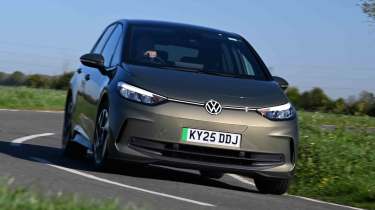New eVED pay-per-mile road tax: how will it work and are EVs getting pricier than petrol cars?
The incoming charges will come on top of existing VED from April 2028

Proposals have been revealed illustrating how Rachel Reeves’ pay-per-mile road tax scheme for EVs could be implemented, with electric car drivers set to pay an average of £200-300 per year in ‘eVED’ (Electric Vehicle Excise Duty) on top of the annual cost of VED following the Budget.
From April 2028, drivers of electric cars ranging from SUVs like the Tesla Model Y, to superminis like the Renault 5 will be subject to a form of road pricing, which will cost three pence per mile driven.
Those driving a plug-in hybrid (PHEV) such as the Toyota Prius will also have to pay, but at a reduced rate of one-and-a-half pence per mile – both this and the EV figure will increase annually in line with the Consumer Price Index. All of this will come on top of Vehicle Excise Duty, which currently stands at £195 per year.
How will eVED pay-per-mile tax work?
So how will it work? Well, nothing is set in stone but the Treasury’s official consultation document suggests that dealers could “prepackage” the cost of VED at the point of purchase for new vehicles, whilst older cars could have their mileage recorded at the annual MoT exam.
For cars aged under three years old that haven’t had their road tax bundled within the price of the car, owners could potentially submit their estimated mileage – much like when applying for insurance. They would then prepay annually or monthly based on the estimated distance, either receiving a rebate or a bill at the end of the year if they are under or over the prediction. The mileage would be verified as part of an annual mileage check exam.
The AA’s president Edmund King said: “Drivers will naturally have questions about such a scheme, which is why The AA will lead the charge for a fair and transparent system which is easy to understand. We will also need protections for certain groups, like carers who use their car for work and rural drivers who are more car dependent.”
Will eVED discourage EV buyers?
The new tax, according to a report leaked early by the Office for Budget Responsibility (OBR), will raise roughly £1.4 billion per year by 2029-30. This is despite the fact that the OBR also estimates that by the end of 2031 there will be 440,000 fewer EVs being sold than there would have otherwise been as prospective buyers are put off by the additional charges.
Labour hopes it won’t lose everyone, though, because it has also simultaneously increased the threshold above which the £425 Expensive Vehicle Supplement to VED is paid; from April 2026, only EVs costing £50,000 or more will be liable, as opposed to the current £40,000 threshold, which will remain for other fuel types.
Nevertheless, a spokesperson for Ford UK said: “This Budget sends a confusing message at a critical moment in the EV transition. Extra investment in charging and the Electric Car Grant is positive, but it cannot offset the impact of a poorly timed pay-per-mile charge on EVs and hybrids. Against a hugely challenging market, and compliance targets drifting out of reach, this is the wrong tax at the wrong time.”
Such a sentiment is mirrored by the CEO of charging firm Instavolt, Delvin Lane, who pointed out how investment in roads and charging infrastructure is being “overshadowed by new cost pressures, including the introduction of pay-per-mile charging. Such policies risk reducing EV uptake and weakening the investment case for expanding the rapid-charging network.”
What will pay-per-mile tax mean for EV costs vs petrol?

A key selling point of EVs has long been the low running costs. However, road pricing will narrow the gap between electric and ICE in terms of how much drivers spend on fuel.
Comparing a Volkswagen Golf with its electrified counterpart, the ID.3, our analysis shows that even following the tax’s introduction, running an EV will remain the cheaper option by far when charging at domestic off-peak rates.
According to the official WLTP combined cycle efficiency figures, an ID.3 Pure Match will set you back just two pence per mile (plus three pence for the new tax) at the average off-peak home electricity rate of eight pence per kilowatt hour (kWh).
At the same time, the petrol and diesel Volkswagen Golf equivalents will cost around 12 and 10 pence per mile respectively at the current price for fuel – although bear in mind that fuel duty is expected to rise in the coming years.
When plugging in at the current Ofgem energy price cap of 26p per kWh, things get a little closer; nine pence per mile with the mileage tax included would make the ID.3 roughly the same cost to fuel as a petrol or diesel Golf.
Charge using more expensive public charging infrastructure, however, and you can be paying up to 90p per kWh. This would make per-mile fuel costs of our ID.3 significantly more than filling up a Golf with petrol.
There are, of course, many, many variables in calculating fuel costs - let alone overall car running costs - but the pay-per-mile tax is going to make it less likely that the sums add up in the electric car’s favour.
Get even more from Auto Express, follow our channels...
Find a car with the experts




